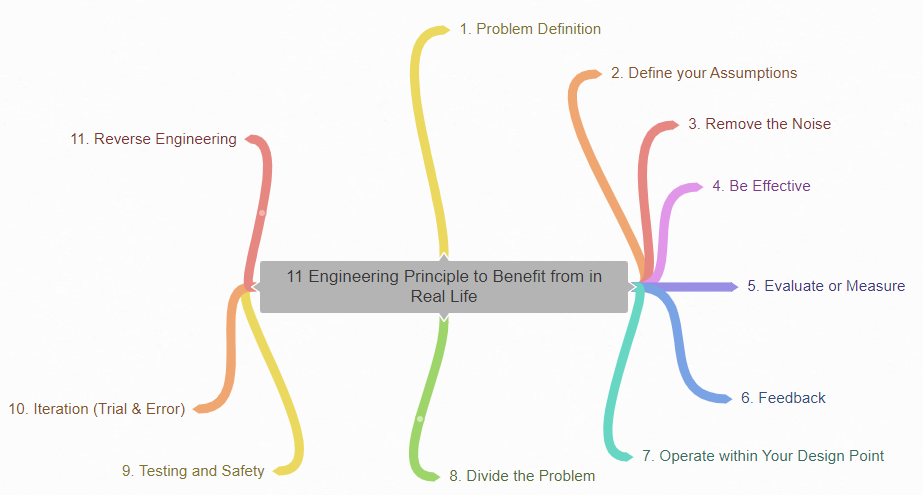In the name of Allah, most gracious and most merciful,

Engineering is a great and useful discipline, in general, where many principles of it could be applied to real-life for our benefit. Here are 11 principles that I think could be applicable in real-life to help us live more effectively and efficiently.
Table of Contents
1. Problem Definition
“A Problem Well Stated is Half Solved”
This quote is usually attributed to Charles Kettering, who was head of research at General Motors
Try to define your problem clearly or the situation you are facing in life clearly. What exactly is the problem? Be clear and accurate.
2. Define your Assumptions
Not all solutions are necessarily valid in all situations. If you are using an already developed solution then you should know the context of its implementation and the assumptions made while developing the solution. By this, you define when your solution is valid and when it is invalid.
But why assumptions exist in engineering?
Because reality is usually more difficult than the mathematical engineering models. In other words, the model represents part or parts of the reality and not all of it. By the way, that is one of the reasons behind the existence of errors in engineering. It is usually okay to have errors, but these errors should be within certain acceptable limits and these limits depend on many factors.
Therefore instead of leaving problems unsolved, engineers solve them with an acceptable error by using models that approximate the reality.
Being aware of the assumptions of the solution you are using will help you:
- Identify your solution weaknesses so that you could improve it if it is possible.
- Know when the model could be safely applied and when using that same model or solution with these assumptions is completely unacceptable.
3. Remove the Noise
Noise could be looked at as things that are not needed to solve the problem. Leaving them could distract us from reaching the appropriate solution. Noise could introduce bias into the solution as well which could make the solution less generalizable.
4. Be Effective
You don’t have to reinvent the wheel if somebody has invented it. You can instead improve and build on that existing wheel.
Similarly, if you are facing a problem that others have previously faced. First, search for existing solutions and see if any of them work. If you tried but none of them worked, then why not try to modify that solution and see what happens?
What if neither of the solutions worked with you? Well, then by your previous exposure to solutions that didn’t work, I think you could now be more prepared to develop a new solution. At least now you have experimented and knew what didn’t work to avoid falling into similar mistakes. That is efficiency: Save your time.
Disclaimer
When I talked about devising new solutions if none of the other solutions worked, I was talking about solving general problems that we face in life. But if you try to devise a solution in a domain or field that is outside of your specialization or expertise, then you should ask experts instead of devising your own solution. You could start thinking of devising solutions in a specific field if you have the prerequisites and tools of that field which usually takes time. Otherwise, mostly you are just wasting your time since you don’t have the right tools.
5. Evaluate or Measure
If you could evaluate or measure anything in your problem or in something else you are doing, then don’t leave it. It may help you a lot to see where are you from the final solution to your problem. Even if you have some approximate numbers or estimations, I think it will still be beneficial.
Evaluations and measurements make it easier for you to improve.
6. Feedback
Feedback exists when two things exist:
- A target or goal or a specific result you want to reach
- There is a measurement or evaluation of the final result you have already reached
By looking at the difference between these two things, you could start to take corrective action which means adjusting your actions to move you closer to your goal or target. By doing this, you are minimizing your error or in other words, you are moving closer to your target.
That’s why measurement or evaluation was the previous engineering principle.
7. Operate within Your Design Point (Or if you wish you could say internal and external environment)
The design point is the point of optimum performance where you expect something to operate most of the time. Engineers try to ensure that the operating conditions of whatever they are building are close to this design point for better overall performance.
If the operation is outside a certain threshold of the design point you are in the off-design. Operating in the off-design for a long time could lead to machine fast deterioration and much less life expectancy.
Examples of design point in real life could be:
- Healthy Eating Habits
- Proper Exercise
- Good working, and living environment that aims to increase your productivity. In other words, try to make the environment suitable for what you are doing if this is possible
8. Divide the Problem
If the problem you are solving is big or seems difficult, you could divide it into small parts and then solve each part. After this, you can combine these small parts while taking the suitable integration between these parts into consideration to finally solve the original problem.
9. Testing and Safety
Provided that you have solved your problem, you may be not sure of the solution’s validity. Therefore making a virtual environment could be beneficial to avoid possible impactful errors in your solution. Moreover, this improves your solution’s safety.
10. Iteration (Trial & Error)
After applying all of the previous 9 Engineering principles there could still be problems in any of your solutions starting from the problem definition until testing and validating the solution because we are humans and errors are expected from us. These errors could appear on virtual environment testing or on real life testing after actually implementing your solution. The concept here is to use the feedback and your results and see what went wrong and how you could possibly improve your solution.
You may even revert back to restating your problem definition since on implementing it, you discovered that your problem definition wasn’t accurate enough for instance.
By proper trial and error while benefiting from the feedback, hopefully, your solution could keep becoming better.
11. Reverse Engineering
Given a certain solution that worked, you could try to analyze how such a solution has been made and developed. By doing this you are somehow trying to discover the process that has lead to this final solution.
Instead of designing and finding a solution, you are working backward to know how this existing solution was developed. This could be useful for beginners who want to know how experts design great solutions.
Finally
Thank you. I hope this post has been beneficial to you. I would appreciate any comments if anyone needed more clarifications or if anyone has seen something wrong in what I have written in order to modify it, and I would also appreciate any possible enhancements or suggestions. We are humans, and mistakes are expected from us, but we could also minimize those mistakes by learning from them and by seeking to improve what we do and how we do it.
Allah bless our master Muhammad and his family.

